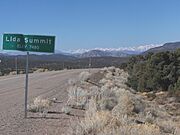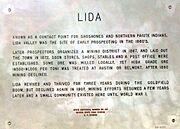Lida, Nevada facts for kids
Quick facts for kids
Lida, Nevada
|
|
|---|---|

Abandoned house in Lida
|
|
| Country | United States |
| State | Nevada |
| County | Esmeralda |
| Time zone | UTC-8 (Pacific (PST)) |
| • Summer (DST) | UTC-7 (PDT) |
| Reference #: | 157 |
Lida, Nevada is a small ghost town located in Esmeralda County, Nevada. It's very close to the border with California. A ghost town is a place where most people have left, and it's mostly empty now. Lida is officially recognized as a "populated place" by the GNIS (Geographic Names Information System), even though few people live there today. You can find Lida on Nevada State Route 266, just north of Magruder Mountain.
Contents
The Story of Lida
Early Days and Naming
The first white settlers arrived in Lida in 1867. The town got its name from Lida, who was the wife of a prospector named David Buel from nearby Austin. Before these settlers came, the area where Lida now stands was a camp for the Shoshone and Northern Paiute Native American tribes.
Mining Booms and Busts
Lida's first big growth spurt happened because people found silver there. But by 1880, most of the silver was gone, and mining slowed down.
Another exciting time came in 1905. This was because gold was discovered in Goldfield, a town not too far away. This brought Lida's population to its highest point, with about 300 people living there. However, this gold rush only lasted for two years.
A third, smaller burst of activity happened just before World War I.
The Road Less Traveled
In 1913, an important road called the Roosevelt Midland Trail passed through Lida. This was one of the very first marked roads that went all the way across America. It was planned to connect traffic to California.
Both the Federal Aid Highway Act of 1921 and the Pershing Map of 1922 suggested that the route through Lida should become part of the new national highway system. But when the United States Numbered Highway System was created in 1926, Lida was not included. Instead, planners chose the Arrowhead Trail through Las Vegas to connect traffic to Southern California. This road was later renamed U.S. Route 91.
Life in Lida
Lida had its own post office, which was open from 1873 until 1932. Today, the land where Lida once stood is private property.
Gallery
-
Lida Summit, looking west to the Sierra Nevada
See also
 In Spanish: Lida (Nevada) para niños
In Spanish: Lida (Nevada) para niños





